
Test drive Audi Q7 60 TFSI, BMW X5 45e: SUV models with plug-in hybrid
Content
Big cars, six cylinders, great traction and a clean environmental conscience
In the upper class of the SUV segment, they care about their image - Audi and BMW are adding plug-in hybrid versions of their Q7 and X5 models. They can be charged from a wall outlet and run on electricity only. But the real pleasure of driving is the powerful six-cylinder engines.
A person who buys a high-end SUV cannot be suspected of having dark green environmental awareness. However, kids of the Fridays for Future generation would rather go to the next demonstration than let them drive them in a regular Audi Q7 or BMW X5. Now, however, the luxury of driving high-status mobile icons can be combined with at least a hint of sustainability – after all, gas-electric hybrids can travel miles with pure electric propulsion.
On the auto motor and sport route to determine the consumption of electric vehicles, the Q7 managed to go 46 kilometers without the help of a V6 engine, and the X5 honked for 76 kilometers before turning on the usual six-cylinder engine. If a person begins to practice eloquence with the explanation that these electric lines also do not illuminate the CO2 balance to a shine, one can answer: yes, but it is the large SUV models that are often used in the city. And right here, at least in theory, they can only move with electricity - if they are regularly charged in the Walbox.
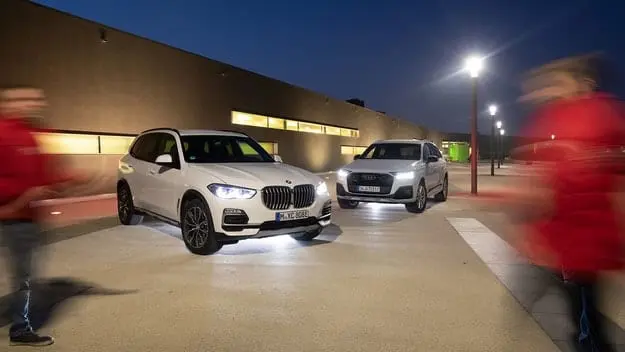
Benefits of Waiting
However, the wall charger in question, which is suitable for a home garage, is only on the BMW accessories list; Audi customers are forced to look for a competent company selling and installing household appliances.
In the 32-amp and 400-volt Audi case, it takes 78 minutes to charge on a 20-kilometer run, drawing current from two of the three phases offered. X5 hangs on the cable much longer, more precisely 107 minutes. At the same time, it only charges in one phase. It takes 6,8 hours to fully charge the battery (three hours for Audi). The reward for a longer wait is the increased autonomous mileage mentioned at the beginning, thanks to the larger battery capacity (21,6 instead of 14,3 kilowatt-hours).
Another advantage BMW has over the competition is the ability to charge the battery on the road with an internal combustion engine – in case you want or need to move without local emissions to the next ecological zone. This gives three additional flexible points in hybrid mode. But the performance can be much higher, because if the power electronics allow, the charging time will be shorter.
Otherwise, both companies do not offer the so-called fast charging of CCS speakers for their plug-in models, which have recently become quite common in supermarket parking lots. Why not charge electricity while shopping for a week? Unfortunately, this is not possible with high-end SUV models tested here; during this time they can absorb energy only for a few extra kilometers from the network. Therefore, both cars receive only two points when assessing charging capabilities.
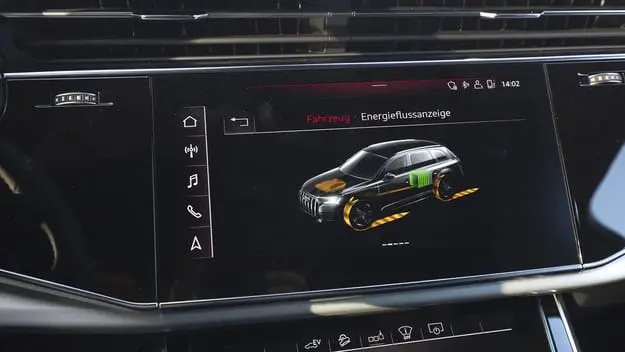
And how the stored energy will be converted into movement depends on whether you have indicated your goal in the navigation system. And what driving mode did you choose from. With factory settings, the Q7 goes into electric mode, while the X5 prefers a hybrid. Then the appropriate working environment determines the form of the drive - in towns and villages it is mainly electric, while on the highway, on the contrary, the gasoline engine predominates. Clearly, BMW prefers to offer an electric drive option for a longer period of time, while the Q7 runs at the maximum current possible - even in cases where the driver has deliberately selected the hybrid mode button. So to say, the supply of kilowatt-hours is consumed directly.
This also happens with the X5 if you have selected electric mode. Thanks to this, the car, like the Audi model, floats in the stream up to a speed of 130 km / h without disturbing others. This is an important takeaway for many potential buyers - the electric mode does not turn two SUV models into giant carts, that is, it does not tie them to the city. And for many, but other potential customers, another established fact may be decisive: switching between two types of drives and their simultaneous operation can usually be heard, but not felt.
With electric support, both SUV models are stronger than their closest cousins, the traditional Q7 55 TFSI and X5 40i versions, both with 340 hp. under the front cover. And above all, there are no turbo lags in hybrids; their propulsion systems start working instantly.
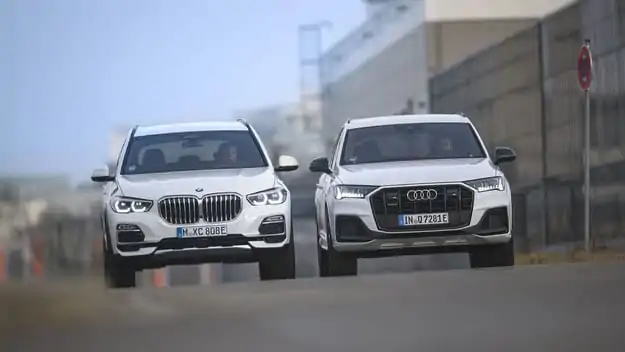
However - and this should be mentioned - not every buyer is driven by the idea of fulfilling their desire for a large SUV model in the most environmentally friendly way possible. For some, while they boast hybrid status, what really matters most is the acceleration function of the electric motors and their extra torque. The combination thus gives up to 700 Newton meters (system power: 456 hp) in Audi and 600 Nm (394 hp) in BMW. With these values, the two 2,5-ton giants instantly launch forward - given the power data, everything else will be a bitter disappointment.
Even more than after Q7, the electric car in X5 hides the time during which the turbocharger picks up speed. Like a naturally-aspirated engine with large pistons, the three-liter inline six responds to the gas supply with an instant push forward. Then it engages and constantly reaches high revs with the best possible support for a soft and high-speed eight-speed automatic transmission. We value this high drive culture with maximum points.
And in terms of lateral dynamics, BMW is on top. For that matter, this model is 49kg lighter and not as clumsy as the Audi representative crosses secondary roads - also because the test car is equipped with a rear axle control system. However, this promising agile technique left us with a bad impression about a year ago in the X5 40i, with its restless cornering behavior where reaching the traction limit hid a moment of surprise.
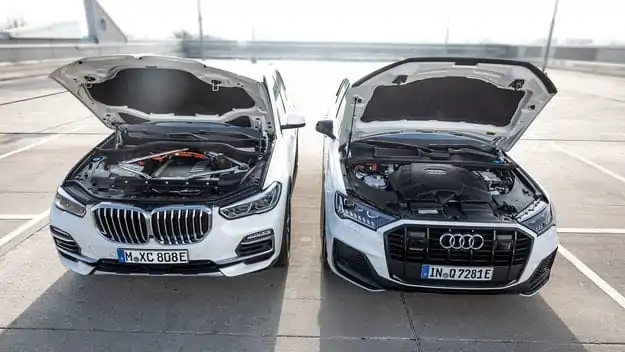
Now, the 323-pound hybrid seems to overdo it and more confidently bypass pylons in the obstacle test. As in small bends, it demonstrates settings with a stealthily heavy rear end that almost completely keeps it from understeering. The main trend in the basic behavior in the turn, by the way, is explained by another look at the distribution of weight. Therefore, in test vehicles, we weigh two axles separately; in the case of the X5, it turned out that 200 kg of excess weight load the rear axle. This has a calming effect on road behavior.
However, when we were driving along the highway, BMW did not like the neural steering around the middle position, which led to the removal of one point for driving in the right direction. In general, the two standard models of air-conditioned SUVs are responsible for their passengers, and in the long run, Audi flatters them a little more. The car responds more softly to short strokes and allows less aerodynamic noise in the cabin, so Ingolstadt wins the victory in the comfort section. By the way, both test cars had additional acoustic glazing.
Since the high-voltage batteries are hidden under the boot floor, a third-row seat is not possible. The hybrid drive principle also limits cargo space. Audi, however, has a maximum of 1835 liters (BMW has 1720). In addition, in the Q7 the lower parts of the rear seats can be folded forward like in a van (for an additional 390 euros).
In terms of body and flexibility, the large metal body plays a positive role, but in the review its effect is rather negative. However, Audi also triumphed in the back. And why is he still losing in the assessment of qualities? Because it is slightly behind the braking distance and safety equipment and driver assistance. But also because it consumes on average more fuel and electricity, and also travels at a shorter distance with an electric drive.
... when connected
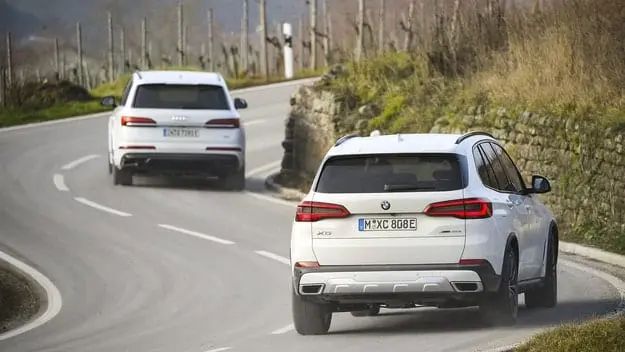
To calculate the cost of the test, we assume that two plug-in hybrids travel 15 kilometers a year and are regularly charged from a wall outlet. Further, we assume that two-thirds of this run is short distance covered by electricity only, and the remaining 000 kilometers in hybrid mode, in which the car decides what type of ride it is.
Under these conditions, the Audi model receives a test consumption of 2,4 liters of gasoline and 24,2 kilowatt hours of electricity per 100 kilometers. In terms of the energy density of gasoline, this corresponds to the combined equivalent of 5,2 l / 100 km. This low value is achieved due to the high efficiency of the electric motor.
In the BMW, the result is just 4,6 liters per 100 kilometers - which can be obtained by collecting 1,9 l / 100 km of gasoline and 24,9 kWh. As already mentioned, this data, which sounds almost like a fairy tale, is based on the assumption that SUV models will regularly hang on the home stand and will be loaded from it at the lowest price.
By the way, the higher efficiency of the X5 does not have a positive effect on the cost of the car, since the difference in consumption is too small. However, BMW takes a longer one-year warranty on its product and earns points with a lower starting price and slightly cheaper deals on optional equipment. At the same time, the X5 wins in the cost section and in the test as a whole - the more economical and the better.
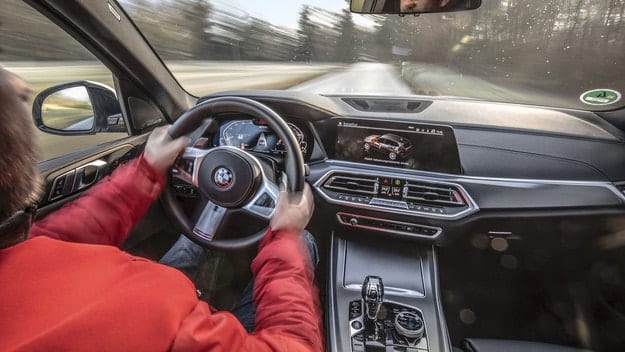
Hack and predictor Aviator
- BMW X5 xDrive 45e (498 points)
X5 is more economical, travels long distances only on electricity and stops better. It brings him victory. Extra points bring him a lower price and a better guarantee. - Audi Q7 60 TFSI e (475 points)
The more expensive Q7 has more practical advantages and internal flexibility, almost like a wagon. The battery charges faster, but the hybrid system is less efficient.

